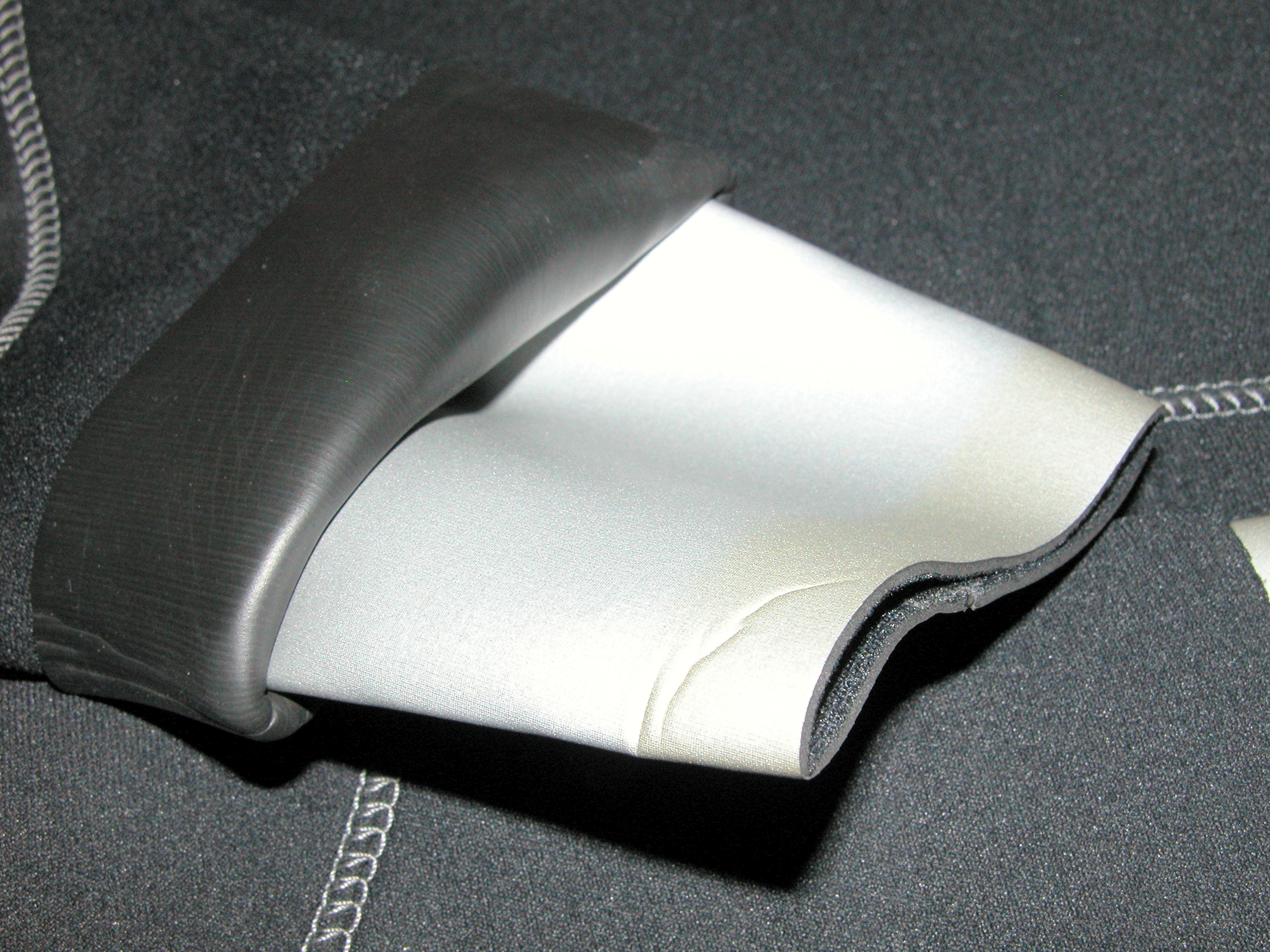|
River Bugging
River Bugging is a whitewater sport where a single person navigates a stretch of river in a craft known as a River Bug. The river bug is a small inflatable craft with an inflatable tube at each side of the user and an inflatable back rest behind. The user sits between the tubes and can be secured into the craft by means of a waist strap. The user would normally wear a wetsuit, swim fins and paddle mitts whilst 'bugging'. The swim fins and paddle mitts are the only means of steering and propulsion, as no paddle is carried on a river bug. Bugging is done 'feet first' which helps the user push off rocks etc. whilst navigating the rapids of a river. The river bug was inspired by the desire to improve on the practice of descending a river on an inner tube. River bugging is largely done as a sport organised by whitewater rafting activity providers. The sport originated in New Zealand, but is gaining popularity in the UK, and mainland Europe. River bugs are also now being used for ot ... [...More Info...] [...Related Items...] OR: [Wikipedia] [Google] [Baidu] |
Whitewater
Whitewater forms in a rapid context, in particular, when a river's gradient changes enough to generate so much turbulence that air is trapped within the water. This forms an unstable current that froths, making the water appear opaque and white. The term "whitewater" also has a broader meaning, applying to any river or creek that has a significant number of rapids. The term is also used as an adjective describing boating on such rivers, such as whitewater canoeing or whitewater kayaking. Fast rivers Four factors, separately or in combination, can create rapids: gradient, constriction, obstruction, and flow rate. Gradient, constriction, and obstruction are streambed topography factors and are relatively consistent. Flow rate is dependent upon both seasonal variation in precipitation and snowmelt and upon release rates of upstream dams. Streambed topography Streambed topography is the primary factor in creating rapids, and is generally consistent over time. Increase ... [...More Info...] [...Related Items...] OR: [Wikipedia] [Google] [Baidu] |
Wetsuit
A wetsuit is a garment worn to provide thermal protection while wet. It is usually made of foamed neoprene, and is worn by surfers, divers, windsurfers, canoeists, and others engaged in water sports and other activities in or on water. Its purpose is to provide thermal insulation and protection from abrasion, ultraviolet exposure, and stings from marine organisms. It also contributes extra buoyancy. The insulation properties of neoprene foam depend mainly on bubbles of gas enclosed within the material, which reduce its ability to conduct heat. The bubbles also give the wetsuit a low density, providing buoyancy in water. Hugh Bradner, a University of California, Berkeley physicist, invented the modern wetsuit in 1952. Wetsuits became available in the mid-1950s and evolved as the relatively fragile foamed neoprene was first backed, and later sandwiched, with thin sheets of tougher material such as nylon or later spandex (also known as lycra). Improvements in the way jo ... [...More Info...] [...Related Items...] OR: [Wikipedia] [Google] [Baidu] |
Swim Fins
Swimfins, swim fins, diving fins, or flippers are finlike accessories worn on the feet, legs or hands and made from rubber, plastic, carbon fiber or combinations of these materials, to aid movement through the water in water sports activities such as swimming, bodyboarding, bodysurfing, float-tube fishing, kneeboarding, riverboarding, scuba diving, snorkeling, spearfishing, underwater hockey, underwater rugby and various other types of underwater diving. Swimfins help the wearer to move through water more efficiently, as human feet are too small and inappropriately shaped to provide much thrust, especially when the wearer is carrying equipment that increases hydrodynamic drag. Very long fins and monofins used by freedivers as a means of underwater propulsion do not require high-frequency leg movement. This improves efficiency and helps to minimize oxygen consumption. Short, stiff-bladed fins are effective for short bursts of acceleration and maneuvering, and are useful f ... [...More Info...] [...Related Items...] OR: [Wikipedia] [Google] [Baidu] |
Rafting
Rafting and whitewater rafting are recreational outdoor activities which use an inflatable raft to navigate a river or other body of water. This is often done on whitewater or different degrees of rough water. Dealing with risk is often a part of the experience. This activity as an adventure sport has become popular since the 1950s, if not earlier, evolving from individuals paddling to rafts with double-bladed paddles or oars to multi-person rafts propelled by single-bladed paddles and steered by a person at the stern, or by the use of oars. Rafting on certain sections of rivers is considered an extreme sport and can be fatal, while other sections are not so extreme or difficult. Rafting is also a competitive sport practiced around the world which culminates in a world rafting championship event between the participating nations. The International Rafting Federation, often referred to as the IRF, is the worldwide body which oversees all aspects of the sport. Equip ... [...More Info...] [...Related Items...] OR: [Wikipedia] [Google] [Baidu] |
Water Polo
Water polo is a competitive sport, competitive team sport played in water between two teams of seven players each. The game consists of four quarters in which the teams attempt to score goals by throwing the water polo ball, ball into the opposing team's goal (sport), goal. The team with the most goals at the end of the game wins the match. Each team is made up of six field players and one Goalkeeper (water polo), goalkeeper. Excluding the goalkeeper, players participate in both offensive and defensive roles. It is typically played in an all-deep swimming pool, pool where players cannot touch the bottom. A game consists mainly of the players swimming to move about the pool, treading water (mainly using the eggbeater kick), passing the ball, and shooting at the goal. Teamwork, tactical thinking and awareness are also highly important aspects. Water polo is a highly physical and demanding sport and has frequently been cited as one of the most difficult to play. Special equipment ... [...More Info...] [...Related Items...] OR: [Wikipedia] [Google] [Baidu] |
Whitewater Sports
Whitewater forms in a rapid context, in particular, when a river's gradient changes enough to generate so much turbulence that air is trapped within the water. This forms an unstable current that froths, making the water appear opaque and white. The term "whitewater" also has a broader meaning, applying to any river or creek that has a significant number of rapids. The term is also used as an adjective describing boating on such rivers, such as whitewater canoeing or whitewater kayaking. Fast rivers Four factors, separately or in combination, can create rapids: gradient, constriction, obstruction, and flow rate. Gradient, constriction, and obstruction are streambed topography factors and are relatively consistent. Flow rate is dependent upon both seasonal variation in precipitation and snowmelt and upon release rates of upstream dams. Streambed topography Streambed topography is the primary factor in creating rapids, and is generally consistent over time. Increased f ... [...More Info...] [...Related Items...] OR: [Wikipedia] [Google] [Baidu] |
Boating
Boating is the leisurely activity of travelling by boat, or the recreational use of a boat whether powerboats, sailboats, or man-powered vessels (such as rowing and paddle boats), focused on the travel itself, as well as sports activities, such as fishing or waterskiing. It is a popular activity, and there are millions of boaters worldwide. Types of boats Boats (boat types) can be categorized into 3 different types types of board categories, unpowered, motor boats, and sailboats.Recreational boats (sometimes called pleasure craft, especially for less sporting activities) fall into several broad categories, and additional subcategories. Broad categories include dinghies (generally under 16 feet (5 m) powered by sail, small engines, or muscle power) usually made from hardwood or inflatable rubber. paddle sports boats (kayaks, rowing shells, canoes), runabouts (15–25 ft. (5–8 m) powerboats with either outboard, sterndrive, or inboard engines), daysailers (14–25 Ft. (4–8 ... [...More Info...] [...Related Items...] OR: [Wikipedia] [Google] [Baidu] |
.jpg)




